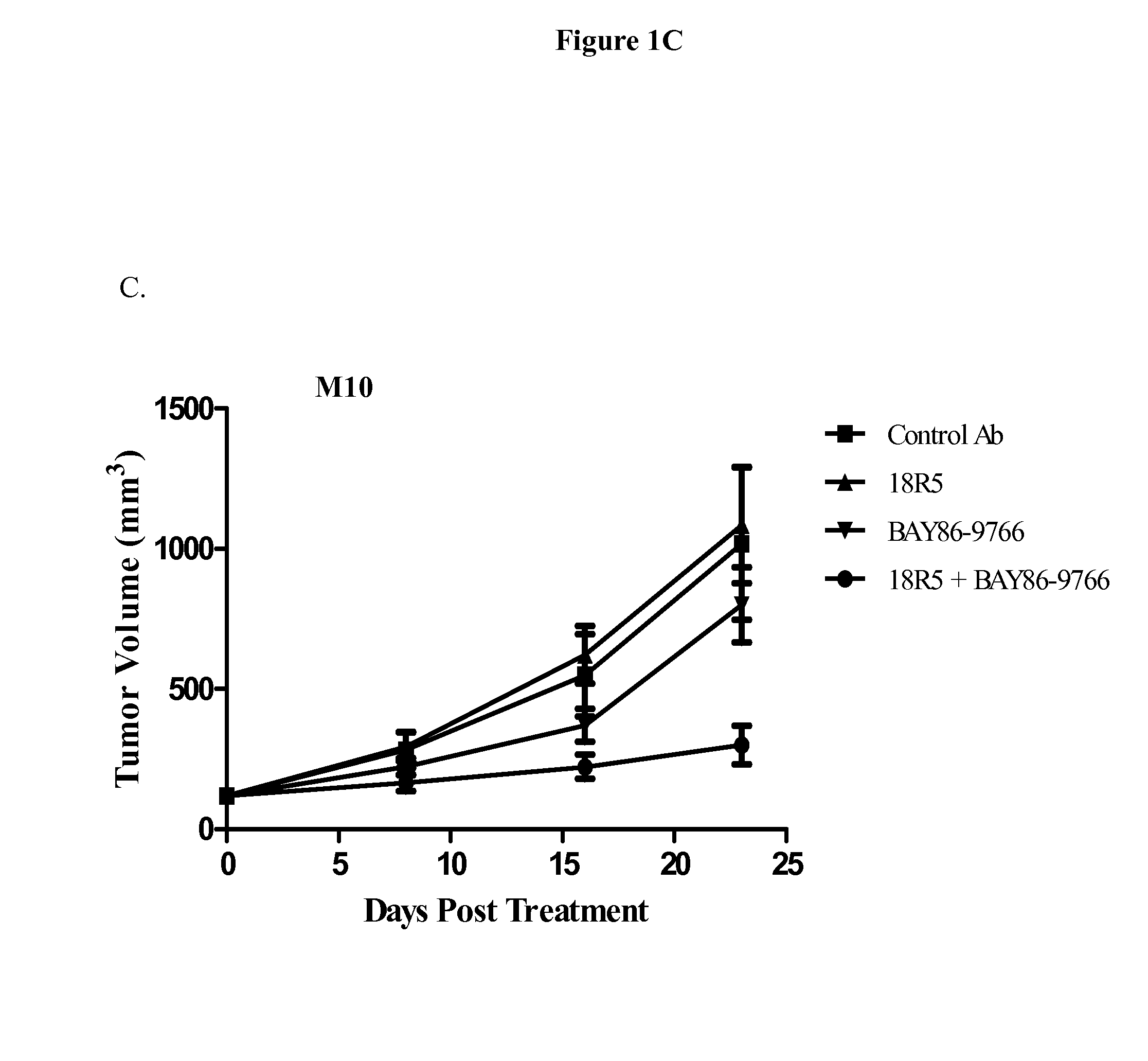Combination Therapy for Treatment of Cancer
a cancer and cancer technology, applied in the field of cancer treatment, can solve the problems of adding or synergistic effects, etc., and achieve the effects of reducing toxic side effects, increasing the therapeutic index of the agent(s), and reducing the likelihood of resistance to an agen
- Summary
- Abstract
- Description
- Claims
- Application Information
AI Technical Summary
Benefits of technology
Problems solved by technology
Method used
Image
Examples
example 1
Characterization of Melanomas Tumors
[0295]A collection of xenografts have been established which are derived from patient melanoma tumors. The tumors were expanded by in vivo passage in NOD-SCID mice without any intervening in vitro cell culture. Genomic DNA samples were isolated from primary and passaged tumors using a Genomic DNA Extraction Kit (Bioneer Inc., Alameda, Calif.) following the manufacturers' instructions. The quality of the isolated DNA was checked by visualizing the DNA samples on a 1% agarose gel or a 0.8% E-Gel (Invitrogen Corporation, Carlsbad, Calif.). The DNA was confirmed to be intact by the presence of an approximately 20 kb size band with little or no visible degradation. The purified genomic DNA samples were sent to SeqWright Technologies, (Houston, Tex.) for nucleotide sequence analysis. The B-Raf, N-Ras and K-Ras genes were obtained by amplifying genomic DNA samples with the Repli-G Mini Kit (Qiagen, Valencia, Calif.) followed by PCR amplification and puri...
example 2
Inhibition of OMP-M3, OMP-M7, and OMP-M10 Tumor Growth In Vivo
[0297]Single cell suspensions of OMP-M3, OMP-M7 and OMP-M10 melanoma tumor xenografts (20,000 cells) were injected subcutaneously into 6-8 week old NOD / SCID mice in a 1:1 suspension with Matrigel. Tumors were allowed to grow until they reached an average volume of 200 mm3. The mice were randomized (n=10 per group) and treated with anti-FZD antibody 18R5, control antibody 1B7.11, MEK inhibitor BAY 86-9766, or a combination of antibody 18R5 and BAY 86-9766. Mice were treated once a week with control antibody 1B7.11 or anti-FZD antibody 18R5 at a dose of 20 mg / kg, administered intraperitoneally. Mice were treated with BAY 86-9766 at a dose of 15 mg / kg daily for 5 days each week, administered orally. For combination treatment, mice were administered anti-FZD antibody 18R5 (20 mg / kg) once a week and BAY 86-9766 (15 mg / kg) daily for 5 days each week. Tumor growth was monitored and tumor volumes were measured with electronic cal...
example 3
Inhibition of OMP-M8 Tumor Growth In Vivo and Tumorigenicity of Treated Tumor Cells
[0300]As shown in Example 1, the OMP-M8 melanoma tumor contains the mutation B-RafV600E. The OMP-M8 tumor was originally obtained from a patient who initially responded to B-Raf inhibitor therapy but who subsequently developed resistance to the B-Raf inhibitor. OMP-M8 melanoma tumor cells (20,000 cells) were injected subcutaneously into 6-8 week old NOD / SCID mice. Tumors were allowed to grow until the average tumor size was approximately 150 mm3. The animals were randomized into four groups (n=10 per group) and treated with B-Raf inhibitor PLX-4720 at doses of 5 mg / kg, 15 mg / kg, and 45 mg / kg, and methyl cellulose vehicle control (1% v / v). PLX-4720 was administered orally for 5 days each week. Tumor growth was measured with electronic calipers on the indicated days after treatment.
[0301]As shown in FIG. 2, the OMP-M8 tumor in a xenograft model was resistant to B-Raf inhibitor PLX-4720 at all doses test...
PUM
| Property | Measurement | Unit |
|---|---|---|
| dissociation constant | aaaaa | aaaaa |
| dissociation constant | aaaaa | aaaaa |
| dissociation constant | aaaaa | aaaaa |
Abstract
Description
Claims
Application Information
 Login to View More
Login to View More - R&D
- Intellectual Property
- Life Sciences
- Materials
- Tech Scout
- Unparalleled Data Quality
- Higher Quality Content
- 60% Fewer Hallucinations
Browse by: Latest US Patents, China's latest patents, Technical Efficacy Thesaurus, Application Domain, Technology Topic, Popular Technical Reports.
© 2025 PatSnap. All rights reserved.Legal|Privacy policy|Modern Slavery Act Transparency Statement|Sitemap|About US| Contact US: help@patsnap.com



